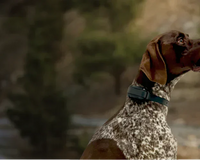Walking on a lead should be an enjoyable experience for both you and your dog.
If you want to ensure your walks together are fun and pleasant, you’ll need to stop your dog pulling on the lead.
How to Stop Your Dog Pulling On Lead:
With a little patience, you’ll be able to curb your dog’s pulling habit. Pulling on a lead is a serious problem that can result in your dog being injured, or you being pulled to the ground.
And if pulling on the lead is due to your dog’s aggression, it could put other people and their pets at risk.
Equipment You Need:
The first thing you need is a regular lead, one that isn’t retractable. Retractable leads don’t always allow you to quickly pull your dog towards you and can be painful if you hold them whilst they recoil.
You'll also need a harness or a collar and some patience.
Equipment You Don’t Need:
You don’t want to encourage your dog to ignore pain, so steer clear of prong collars. Anything that relies on causing your dog intense pain won’t work in the long term.
Also, talk to your vet about recommended harnesses. Sometimes a front-clip harness is suggested. They pull your dog to the side instead of allowing them to put their weight into the harness.
There are concerns that the sideways pressure from this harness could cause long-term damage and affect how your dog carries their weight. It’s best to talk to your vet about the best options for your dog.

The Best Way to Stop Dog Pulling on Lead:
These are the three steps you will need to get familiar with to stop lead pulling. 1. Begin walking with your dog in either the garden, park or street. 2. As soon as your dog pulls on the lead or adds tension, gently pull the lead back and use a command, “heel” for example.3. If your dog relaxes the tension, continue walking. If they don’t, walk in another direction and call them to follow.
If you end up walking in circles, it may indicate that the environment you’re in has too many triggers for your dog. Try moving to a place with fewer stimuli or try wearing your dog out before lead training.
Stay Patient
It will be incredibly frustrating having to stop repeatedly and change directions. It’s ok to feel frustrated, but remind yourself that walking with no tension is not intuitive for your dog. It’s something they will have to learn, and were you ever perfect at anything the first time around?
Use Rewards They Love!
Your dog, like you, prefers different treats at different times. Make sure to keep some toys and treats on you during your training. Reward your dog with toys, treats, some affection and the freedom to continue walking whilst you train together.
Be Consistent
If you occasionally reward your dog pulling on lead by letting them continue to do so, you’ll undo all of the training and effort you’ve put in. Make sure to stop whenever your dog adds tension to the lead and change directions if you must.
If you want to train your dog to pull at certain times, be clear, and use a different kind of harness and a distinct command. Your dog will then associate that difference with the pulling action. An example of when you would want this is if you are training your dog to track or trace other animals.

Why Do Dogs Pull on a Lead?
Knowing exactly why your dog pulls on the lead will make your training efforts more impactful. It feels obvious that your dog is pulling because they want to be further than the lead allows, but there is more to it.
Reason 1: To Get To Something
Some dogs pull to get to something they are focused on. Usually, these dogs walk loosely for most of the time and then pull vigorously at the sight of another dog, human or prey item.
If this is your dog, the lesson here is teaching them self control. You’ll need to train them around these triggers to train them adequately. Take the time to identify what your dog is triggered by so you can train them to respond calmly to it in the future.
Start far from the trigger, far enough that your dog doesn’t even notice it’s there. When your dog is walking nicely, reward them, all the while continuously moving closer to the trigger. Once your dog sees the trigger, call your dog and give a reward for redirecting their attention.
If your dog reacts negatively, take them away, so the trigger is out of sight again and walk until they are continuously responding to you.
When your dog has a high prey drive, reacts to other dogs/humans or is aggressive towards specific triggers, it may take some time to teach them to overcome their response. Make sure you keep yourself and others safe, and if you’re concerned about safety, it may be worth looking into muzzle training.
Reason 2: They Have Lots of Energy
If your dog has too much excess energy, they may lose all sense of self-control when walking on a lead. These dogs will briefly respond to commands and then ignore you as they lose complete control.
The best way to train this out of your dog is to try to wear them out before you walk them on a lead. Using up some energy playing fetch in the garden means they will have less energy to chase triggering stimuli later.
When you’re lead training your energetic dog and they still want to go faster, alternate walking with jogging. You get the best of both worlds as you’ll be rewarding their relaxed lead walking with allowing them to expend their excess energy.
Reason 3: They Don’t Know Any Better
If your dog has never been taught how to walk on a lead, then they won’t understand that being pulled at by the neck means anything.
Some dogs just aren’t intelligent enough to realise that they can avoid getting pulled by the neck if they simply walked with no tension on the lead. If your dog does this, you’ll be teaching them an entirely new way to respond to a lead.
You'll need to be consistent and patient; it will take a lot of time to correct this out of your dog.
Reason 4: They Are Anxious
Terrified dogs will pull on the lead continuously. In their mind, they are either trying to run away or the pressure of the harness feels like security to them.
Either way, if you think this is your dog, you’ll have a dog training challenge ahead of you. Getting an anxious dog to stop pulling on a lead is hard, they are less likely to respond to most rewards.
The first step to training pulling on a lead out of your anxious dog is working in a calm environment. In this relaxed environment, you’re going to practice walking on a lead loosely and rewarding them. Whilst doing this, give them a command (like ‘sit’ or ‘down’) to complete. As you gradually progress them to more triggering environments, this will be their calming activity.
Now you can begin moving them into more triggering, busy environments. If they become too anxious to respond to you or aren’t interested in rewards, take them back to a more comfortable environment and repeat the process.
Reason 5: They Have Only Walked On Retractable Leads
Retractable leads tend to put a little pressure on your dogs, which can encourage them to pull harder. Your dog may be used to that feeling of pressure and you’ll need to teach them that no tension is best. To train this, simply swap leads and implement the three steps outlined above.
Reason 6: They Have Only Had a Tight Lead
If you walk your dog on a really tight lead, they will learn that a tight lead is the only way to walk. Walking on a tight lead tends to encourage pulling. Again, you’ll need to teach them that no tension is best with the three steps listed above.
If You’re Really Struggling to Capture Their Attention
Suppose you are struggling to capture your dog’s attention when out on a walk, we definitely recommend a remote training collar. We hear so many stories from customers of how layering a remote training collar with their other training techniques made their dog safe to be around and calmer.
By using a remote training collar when lead training, you can issue a gentle distraction when they aren’t responding to you at all. Now that you’ve captured their attention, you can issue a command, 'heel'. A remote training collar is about keeping a situation 100% safe, and giving both you and your dog a safety net should a situation turn sour.
If you’re interested in investing in a remote training collar to support your lead training, browse our range here.











